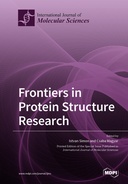Explore

Frontiers in Protein Structure Research
0 Ungluers have
Faved this Work
Login to Fave
In this Special Issue, we aim to represent the vibrant state of protein structure studies at the end of 2021. Recent decades have brought significant changes to the protein structure research field. Thanks to the genome projects and advances in structure determination methods, the number of solved protein structures has increased significantly. Protein structure research is experiencing a new renaissance, and in 2020 the number of deposited structures in the PDB database reached a new record. An assortment of many new frontiers are presented in this collection. A single Special Issue cannot give a comprehensive overview of a large field such as proteins science, but we aim to give a broad overview of current research.
This book is included in DOAB.
Why read this book? Have your say.
You must be logged in to comment.
Rights Information
Are you the author or publisher of this work? If so, you can claim it as yours by registering as an Unglue.it rights holder.Downloads
This work has been downloaded 94 times via unglue.it ebook links.
- 94 - pdf (CC BY) at Unglue.it.
Keywords
- AlphaFold
- amino acid composition
- analytical ultracentrifugation
- B.1.1.7
- B.1.617.2
- Bidirectional long-short term memory
- bifidobacteria
- Biochemical engineering
- Biotechnology
- c1q
- calcium binding proteins
- CASP
- circular dichroism
- co-translational protein folding
- CO2 concentrating mechanism
- coarse-grained modeling
- complex structure
- configurational entropy
- conserved domains
- contact
- convolutional neural network
- COVID-19
- cysteine reactivity
- dataset
- deep learning
- deep sequencing
- diffusion-ordered NMR spectroscopy
- distance
- E484Q
- electrospray ionization mass spectrometry
- energy-dependent protein folding
- Entropy
- erythrocyte membrane
- Erythrocytes
- FK506-binding protein
- FKBP12
- FKBP51
- force fields
- free energy
- free energy landscape
- fucose
- fucosidases
- galactose
- GalNAc
- Genetic Variation
- germline TP53 missense variants
- GlcNAc
- Glucose
- glucuronate
- Glutathione
- glutathionylation
- glycosyl hydrolases
- hereditary breast cancer
- high hydrostatic pressure
- homotetramer
- human milk
- hydrogen/deuterium exchange
- iduronate
- inter-subunit interaction
- intrinsically disordered
- intrinsically disordered proteins
- Keap1
- Li-Fraumeni syndrome
- Manganese
- mannose
- Mass Spectrometry
- Metalloprotein
- molecular chaperones
- multiscale modeling
- mutual synergetic folding
- n/a
- N501Y mutation
- Neu5Ac
- nitrosylation
- NMR
- Nrf2
- Nuclear magnetic resonance spectroscopy
- otoconia
- OTOL1
- otolin-1
- oxidative folding
- Oxidative Stress
- Phosphorylation
- Photosynthesis
- physical model of protein folding
- prediction
- ProSPr
- Protein
- Protein Conformation
- protein dynamics
- Protein Folding
- protein-protein interactions
- protein–ligand interactions
- protein–protein binding
- protein–protein complex
- protein–protein interactions
- quantitative prediction model
- residue packing
- retardants
- retrainable
- ribosomal exit tunnel
- saturation mutagenesis
- Shannon information entropy
- Site-directed mutagenesis
- small-angle X-ray scattering
- solvent accessibility of peptide bonds
- solvent-accessible surface area
- spike protein
- T478K and L452R mutation
- Technology, engineering, agriculture
- Technology: general issues
- tetrabromobisphenol A
- tetrabromobisphenol S
- tetrahydropyran
- thermal shift assay
- thermodynamic stability
- transient complex
- transmembrane proteins
- UBA5
- UFC1
- UFM1
- xylose
- α-helical bundle
Links
DOI: 10.3390/books978-3-0365-6780-8Editions

